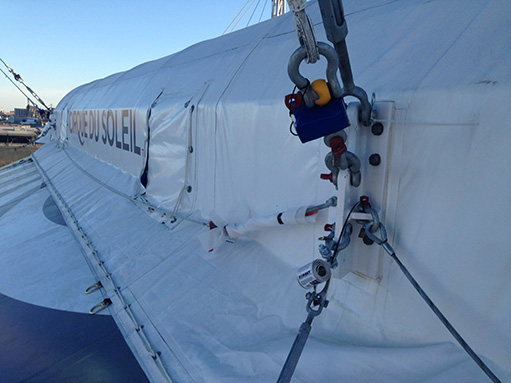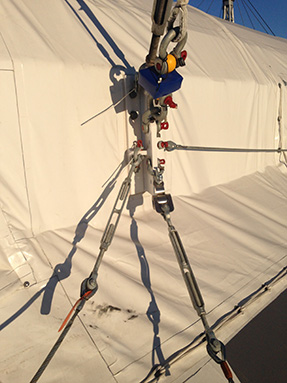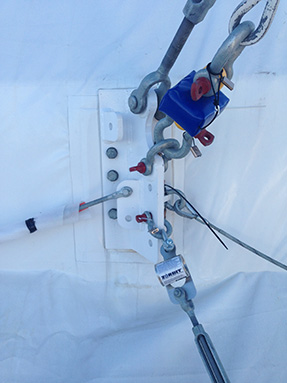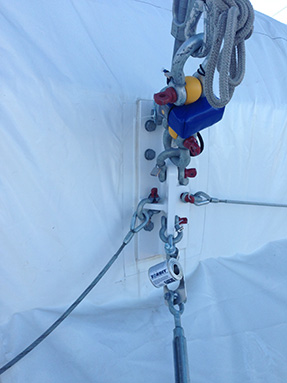Ron StageMaster Puts Acrobats at ease at Cirque du Soleil Show
Load data increases safety to protect audiences and performers from dangerous overloads but also gives a host of other benefits. Newest Cirque du Soleil big top show, Volta, using Ron StageMaster 6000 load cells
While Eilon Engineering’s Ron StageMaster load cells have been providing an added layer of safety protection on Cirque du Soleil shows for years, safety isn’t the only benefit of the load monitoring system as a host of other advantages are being realized as well.
Cirque du Soleil has been thrilling fans for decades whether it’s under the big top in Montreal, in an arena around the world, or on one of their many resident shows. Cirque du Soleil shows aren’t your typical entertainment show however. With a reputation for delivering big production value with acrobats and other high flying acts an integral part of the performance, the forces on the rigging and structure can be complex.
Need for hard data
Cirque du Soleil’s signature striped big top tent, the grand chapiteau with its four masts, central cupola and heavy canvas covering, takes days to construct. Surprisingly, prior to 2007 they had never had reliable hard data on the loads and tension when it is lifted and hung. That changed when Fred Caron, Cirque du Soleil’s Senior Advisor for Acrobatic and Rigging equipment, and Jeff Lucas, Cirque du Soleil Senior Arena Rigging Specialist, addressed the need for more reliable load information in order to make setup and show planning more efficient.
“We never had hard measurement data before,” stated Fred Caron. “We wanted to get factual, empirical data we could use instead of relying on theoretical data. No one had done this. A lot of the data was either engineering or theoretical and no one had actually measured the weight of a canvas as it goes up or the effect of the wind on the canvas. It was also hard to figure out the dynamics created from the acrobatics. It was all based on structural engineering formulas.”
Because the big top is a tensile structure with a life of its own, Caron says it’s important to measure how wind or snow and movement impact the hardware. “There's always some level of movement with the big top,” he says. “It really surprised me when I started asking for hard data. Even the manufacturers only have theoretical wind or snow impact numbers, which are relevant numbers to have in a place like snowy Montreal. Measurements on snow loading and how it distributes on the structure is important info to have.”
.jpg)
Load monitoring
Historically, Cirque du Soleil has used analog dynamometers on big top shows for measuring loads and making sure tensions are what they should be. In 2007, the company turned to using Eilon Engineering load cells on the Varekai big top show and has continued the practice with their latest big top show, Volta, where they use Ron StageMaster 6000 G4 wireless load cells (12.5 ton).
In February 2017, they installed eight of the Ron StageMaster 6000 load cells on the big top when it was lifted and hung, which allowed them to monitor the transfer of load and guarantee that the split between the lifting cable and the suspension cable was equal. “Everything suspended in the big top, including the production equipment, ultimately goes to the masts so the load cells are monitoring all the loads, not just for the setup but also during the show run,” Caron says. “Every time you create a show the creation team will produce a sheet stating what they think the measurements will be. Now with Volta, we can validate the numbers and compare the expected numbers with the actual numbers.” Caron adds that before using the Ron StageMaster load cells the suspension and leveling of the cupola would typically take 40 minutes to an hour. Using the load cells for real-time monitoring, where they can react and make changes right away, it now takes about 15 minutes.
Ron StageMaster system
The Ron StageMaster load cell system on Volta communicates wirelessly to an iPad using portable radio receivers. The system produces an analytical "snapshot" of the load to ensure that it is suspended safely and allows for simultaneous real-time monitoring on one screen of hundreds of individual hanging points, groups or the entire structure. The Ron StageMaster software also allows for overlay of the load map right onto the plot on screen, enabling the rigger to immediately identify the location of an overload and take swift preventative action. Ron StageMaster also provides a record of the show and is compatible with smart phones and tablets and can even send SMS alerts.
The Ron StageMaster system has a transmission distance option of up to 1000 yards (1 km) and can continuously monitor a rig 24/7/365 up to 5000 hours. It contains absolutely no standby or sleep modes, which are risky and unacceptable from a safety perspective. Up to 75 load cells can be monitored and controlled per portable receiver with up to 200 load cells per base station possible using the Central Radio Receiver. Volta can be controlled and monitored accurately in all its phases, from setup through to the last show. The system can even monitor some of the dynamic movement of artists that occurs during performances.
Made of aerospace quality, high-strength alloy steel, the Ron StageMaster 6000 G4 load cell, like all Eilon Engineering load cells, is fatigue rated to withstand unlimited load cycles without the risk of failure or damage to the steel. The Ron StageMaster system is being put to the test on the Volta show in Montreal, where they will be exposed to all types of weather from February’s cold through the heat of summer. That won’t be a problem as they are designed for use in any type of weather.

Greater possibilities
Senior Arena Rigging Specialist Jeff Lucas, who has a long history with Eilon products and was instrumental in bringing them on board for the big top project, mentions another benefit to using load cells, namely the creative possibilities it can open up. He explains: “Most of the time you'll use a load cell system to make sure you're not overloading something - that's the safety side. But there’s another side. When creating something, you're often trying to put as much production into the show to make it the best you can. But when working from theoretical instead of hard data you could be eliminating something that was otherwise possible because of the difficulty in estimating loads. You'll say, ‘that's too heavy, we can't do that’, or ‘that's going to create too much force’, when in actuality, when you have the data, it was ok. You don't want to push the envelope too much but with a system that's giving you data you can push it and be sure that it's safe. It's a question of how many new tricks can they put in there without overloading the system.”
.jpeg)
Another benefit of having load cell-generated data stems from the fact that shows often change throughout their life. “Shows tend to evolve from when they were first rolled out,” Lucas says. “Acts get replaced or rotate with other acts. When you have data to make decisions, you're able to change things more easily because you have the information you need to make the best decision.”
Arena shows
Cirque du Soleil’s big top shows often prove so popular that they turn into wider travelling arena shows, where the cupola is replaced by a central acrobatic grid. Lucas explains that in an arena environment, because there aren’t four big masts to guy to and you can't drive 4-ft stakes into the ground, anchoring is different and therefore the tension and load data changes. “When we first started transferring shows over to arenas we had issues with stability of our structures,” he says. “You're often in a big tall space with nowhere to guy. There are different ways to anchor, you need to know what the anchoring is doing and you need data on what has been changed or added. In order to balance all of the loads on the structure you need a load cell system, both for efficiency and stability. When we started using the Eilon load cell system we began to set up faster. We minimized mistakes and there was less trial and error. The result was that the structure became more stable.”
Cirque du Soleil began using Eilon’s Ron StageMaster 6000 3.5 ton load cells for the OVO arena show in 2015, a wireless system that eliminates long runs of cable and makes troubleshooting easier. “The wireless technology is evolving technology,” Lucas comments. “It gives you the potential to increase the range or push it out to other devices. It's exciting to have technology won’t remain static but evolve with features that can be enhanced so the system stays up to date.”
Eases the mind
When a Cirque du Soleil touring show visits a venue anywhere in the world, the Eilon Ron StageMaster load monitoring system helps reduce the risk of rigging accidents caused by unequal load distribution. It also provides an added level of security for venue personnel. “A lot of attention gets put on our shows, more than a typical show because there is a lot going on and there is a level of calculated risk involved,” Lucas says. “Venues always have a lot of questions about what we do because of the aerial acrobatics and human rigging. But when the venue knows that we have it all on a load cell system, and they can see the load cell data for themselves in real time, it eases their mind.”
“We're evolving technically on all of our shows, not just on the artistic side but using new technology to improve safety, to improve efficiency, to have more data,” concludes Lucas, who says that the goal is to measure all Cirque du Soleil shows. “Anywhere you can improve the safety factor or have more data to make decisions with, then the safer you are.”
Volta is currently playing under a big top in the Old Port of Montreal through July 23rd then runs in Gatineau near Ottawa from August 3rd to the 27th and at Toronto’s Port Lands from September 7th to October 29th.
For more information contact your local Eilon representative or Noga Eilon-Bahar at:
Noga Eilon-Bahar
neb@eilon-engineering.com
www.eilon-engineering.com







.jpeg)






.png) Barcelona Jan 30-Feb 2
Barcelona Jan 30-Feb 2